 W
WAktashite is a rare arsenic sulfosalt mineral with formula Cu6Hg3As4S12. It is a copper mercury-bearing sulfosalt and is the only sulfosalt mineral with essential Cu and Hg yet known. It is of hydrothermal origin. It was published without approval of the IMA-CNMNC, but recognized as valid species by the IMA-CNMNC Sulfosalts Subcommittee (2008).
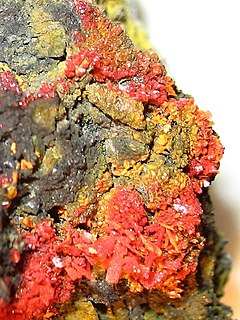 W
WAlacránite (As8S9) is an arsenic sulfide mineral first discovered in the Uzon caldera, Kamchatka, Russia. It was named for its occurrence in the Alacrán silver/arsenic/antimony mine, Pampa Larga, Chile. It is generally more rare than realgar and orpiment. Its origin is hydrothermal. It occurs as subhedral to euhedral tabular orange to pale gray crystals that are transparent to translucent. It has a yellow-orange streak with a hardness of 1.5. It crystallizes in the monoclinic crystal system. It occurs with realgar and uzonite as flattened and prismatic grains up to 0.5 mm across.
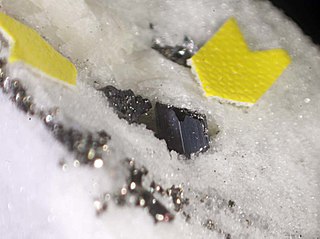 W
WArgentobaumhauerite is a rare mineral with the chemical formula Ag1.5Pb22As33.5S72. Its type locality is the Binn valley in Switzerland.
 W
WArsenolite is an arsenic mineral, chemical formula As4O6. It is formed as an oxidation product of arsenic sulfides. Commonly found as small octahedra it is white, but impurities of realgar or orpiment may give it a pink or yellow hue. It can be associated with its dimorph claudetite (a monoclinic form of As2O3) as well as realgar (As4S4), orpiment (As2S3) and erythrite, Co3(AsO4)2·8H2O.
 W
WArsenopyrite is an iron arsenic sulfide (FeAsS). It is a hard metallic, opaque, steel grey to silver white mineral with a relatively high specific gravity of 6.1. When dissolved in nitric acid, it releases elemental sulfur. When arsenopyrite is heated, it produces poisonous sulfur and arsenic fumes which can be fatal if inhaled in large quantities. With 46% arsenic content, arsenopyrite, along with orpiment, is a principal ore of arsenic. When deposits of arsenopyrite become exposed to the atmosphere, the mineral will slowly oxidize, converting the arsenopyrite into an iron arsenate, a relatively stable compound. Arsenopyrite is generally an acid consuming sulfide mineral unlike iron pyrite which can lead to acid mine drainage.
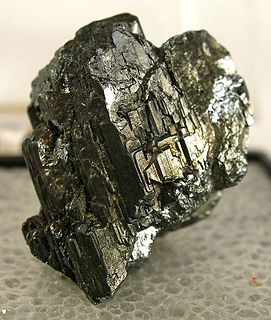 W
WBaumhauerite (Pb3As4S9) is a rare lead sulfosalt mineral. It crystallizes in the triclinic system, is gray-black to blue-gray and its lustre is metallic to dull. Baumhauerite has a hardness of 3.
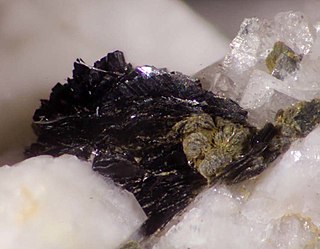 W
WCervandonite is a rare arsenosilicate mineral. It has a chemical formula (Ce,Nd,La)(Fe3+,Fe2+,Ti4+,Al)3SiAs(SiAsO13) or (Ce,Nd,La)(Fe3+,Fe2+,Ti,Al)3O2(Si2O7)(As3+O3)(OH). It has a monoclinic crustal structure with supercell (Z=6), the crystal structure was established as a trigonal subcell, with space group R3m and a = 6.508(1)Ǻ, c = 18.520(3) Ǻ, V 679.4(2) Ǻ3, and Z=3. It was first described by Buhler Armbruster in 1988, but it has proven to be problem due to the extreme scarcity of single crystals and its unusual replacement of silicon and arsenic. Cervandonite is named after the location where it was first described, Pizzo Cervandone (Scherbadung), Italy in the Central Alps.
 W
WChristite is a mineral with the chemical formula TlHgAsS3. It is named after Dr. Charles L. Christ, a member of the U.S. Geological Survey. It usually comes in a crimson red or bright orange color. It has a density of 6.2 and has a rating between 1 and 2 on Mohs Hardness Scale. Christite has an adamantine luster and leaves behind an orange streak. Its crystal system is monoclinic with possible crystal classes of twofold symmetry, mirror plane symmetry, and twofold with a mirror plane. This means it can have radial symmetry, mirror plane symmetry, or mirror plane symmetry perpendicular to the two-fold axis. It is an anisotropic mineral, which means that it exhibits different properties when measured in different directions. In plane polarized light, its color is golden yellow. It is birefringent, which means that it has two distinct indices of refraction. This can be seen when one looks through the microscope with both polars crossed and sees the mineral change colors when it is rotated.
 W
WClaudetite is an arsenic oxide mineral with chemical formula As2O3. Claudetite is formed as an oxidation product of arsenic sulfides and is colorless or white. It can be associated with arsenolite (the cubic form of As2O3) as well as realgar (As4S4), orpiment (As2S3) and native sulfur.
 W
WCobaltite is a sulfide mineral composed of cobalt, arsenic, and sulfur, CoAsS. Its impurities may contain up to 10% iron and variable amounts of nickel. Structurally, it resembles pyrite (FeS2) with one of the sulfur atoms replaced by an arsenic atom.
 W
WEnneasartorite is a very rare mineral with formula Tl6Pb32As70S140. It belongs to sartorite homologous series. It is related to other recently approved minerals of the sartorite series: hendekasartorite and heptasartorite. All come from Lengenbach quarry in Switzerland, which is famous for thallium sulfosalts. Enneasartorite is chemically similar to edenharterite and hutchinsonite.
 W
WFettelite, also known as sanguinite, is a mercury-sulfosalt mineral with the chemical formula Ag16HgAs4S15. The mineral was first described by Wang and Paniagua (1996) who named it after M. Fettel, a German field geologist who collected the first samples from Odenwald. It was first collected in the Nieder-Beerbach mine, 10 km south of Darmstadt, Odenwald, Germany. Its normal occurrence is in hydrothermal veins, which can cut gabbro-diorite intrusives. It is closely related to other rare minerals like dervillite, daomanite, vaughanite and criddleite which are also found in the same type locality as fettelite.
 W
WFreibergite is a complex sulfosalt mineral of silver, copper, iron, antimony and arsenic with formula (Ag,Cu,Fe)12(Sb,As)4S13. It has cubic crystals and is formed in hydrothermal deposits. It forms one solid solution series with tetrahedrite and another with argentotennantite. Freibergite is an opaque, metallic steel grey to black and leaves a reddish-black streak. It has a Mohs hardness of 3.5 to 4.0 and a specific gravity of 4.85 - 5. It is typically massive to granular in habit with no cleavage and an irregular fracture.
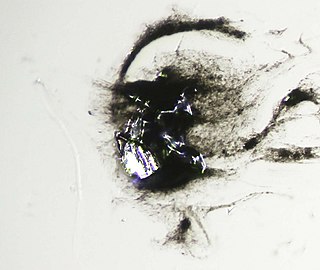 W
WGabrielite is a rare thallium sulfosalt mineral with a chemical formula of Tl6Ag3Cu6(As,Sb)9S21 or Tl2AgCu2As3S7.
 W
WGalkhaite is a rare and chemically complex sulfosalt mineral from a group of natural thioarsenites. Its formula is (Cs,Tl)(Hg,Cu,Zn)6(As,Sb)4S12, making the mineral the only known natural Cs-Hg and Cs-As phase. It occurs in Carlin-type hydrothermal deposits.
 W
WGeocronite is a mineral, a mixed sulfosalt containing lead, antimony, and arsenic with a formula of Pb14(Sb, As)6S23. Geocronite is the antimony-rich endmember of a solid solution series. The arsenic-rich endmember is named jordanite. It occurs as grey, black, to silvery white monoclinic crystals. It is found in hydrothermal veins usually associated with other similar minerals, particularly the sulfides of iron and copper.
 W
WGersdorffite is a nickel arsenic sulfide mineral with formula NiAsS. It crystallizes in the isometric system showing diploidal symmetry. It occurs as euhedral to massive opaque, metallic grey-black to silver white forms. Gersdorffite belongs to a solid solution series with cobaltite, CoAsS. Antimony freely substitutes also leading to ullmannite, NiSbS. It has a Mohs hardness of 5.5 and a specific gravity of 5.9 to 6.33.
 W
WGlaucodot is a cobalt iron arsenic sulfide mineral with formula (Co,Fe)AsS. The cobalt:iron(II) ratio is typically 3:1 with minor nickel substituting. It forms a series with arsenopyrite (FeAsS). It is an opaque grey to tin-white typically found as massive forms without external crystal form. It crystallizes in the orthorhombic system. The locality at Håkansboda, Sweden has rare twinned dipyramidal crystals. It is brittle with a Mohs hardness of 5 and a specific gravity of 5.95. It occurs in high temperature hydrothermal deposits with pyrrhotite and chalcopyrite. Glaucodot is classed as a sulfide in the arsenopyrite löllingite group.
 W
WGratonite is a lead-arsenic sulfosalt mineral, with the chemical composition Pb9As4S15. Gratonite was discovered in 1939 at the Excelsior Mine, Cerro de Pasco, Peru. It is named in honor of geologist L. C. Graton (1880–1970), who had a long-standing association with the Cerro de Pasco mines.
 W
WHendekasartorite is a very rare thallium sulfosalt mineral with formula Tl2Pb48As82S172. It is one of recently approved new members of sartorite homologous series, by enneasartorite and heptasartorite. All new members come from Lengenbach quarry in Switzerland, prolific in terms of thallium sulfosalt minerals. Hendekasartorite is chemically similar to edenharterite and hutchinsonite.
 W
WHutchinsonite is a sulfosalt mineral of thallium, arsenic and lead with formula (Tl,Pb)2As5S9. Hutchinsonite is a rare hydrothermal mineral.
 W
WJordanite is a sulfosalt mineral with chemical formula Pb14(As,Sb)6S23 in the monoclinic crystal system, named after the German scientist H. Jordan (1808–1887) who discovered it in 1864.
 W
WLautite is a rare mineral belonging to the class of sulfides and sulfosalts with the general formula CuAsS. It is orthorhombic and is known to form up to 2.3 cm long prismatic or flat crystals. It is also found as grains or masses.
 W
WLorándite is a thallium arsenic sulfosalt with the chemical formula: TlAsS2. Though rare, it is the most common thallium-bearing mineral. Lorandite occurs in low-temperature hydrothermal associations and in gold and mercury ore deposits. Associated minerals include stibnite, realgar, orpiment, cinnabar, vrbaite, greigite, marcasite, pyrite, tetrahedrite, antimonian sphalerite, arsenic and barite.
 W
WMarrite (mar'-ite) is depicted by the chemical formula PbAgAsS3. It is the arsenic equivalent of mineral freieslebenite (PbAgSbS3), but also displays close polyhedral characteristics with sicherite and diaphorite. Marrite was named in honor of geologist John Edward Marr (1857–1933) of Cambridge, England.
 W
WOrpiment is a deep-colored, orange-yellow arsenic sulfide mineral with formula As2S3. It is found in volcanic fumaroles, low-temperature hydrothermal veins, and hot springs and is formed both by sublimation and as a byproduct of the decay of another arsenic mineral, realgar. Orpiment takes its name from the Latin auripigmentum because of its deep-yellow color.
 W
WPääkkönenite is a metallic grey mineral with the molecular formula Sb2AsS2. It is named after Veikko Pääkkönen (1907–1980), a Finnish geologist.
 W
WPararealgar is an arsenic sulfide mineral with the chemical formula As4S4 also represented as AsS. It forms gradually from realgar under exposure to light. Its name derives from the fact that its elemental composition is identical to realgar, As4S4. It is soft with a Mohs hardness of 1 - 1.5, is yellow orange in colour, and its monoclinic prismatic crystals are very brittle, easily crumbling to powder.
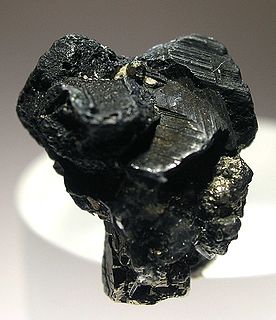 W
WPearceite is one of the four so-called "ruby silvers", pearceite Cu(Ag,Cu)6Ag9As2S11, pyrargyrite Ag3SbS3, proustite Ag3AsS3 and miargyrite AgSbS2. It was discovered in 1896 and named after Dr Richard Pearce (1837–1927), a Cornish–American chemist and metallurgist from Denver, Colorado.
 W
WPolybasite is a sulfosalt mineral of silver, copper, antimony and arsenic. Its chemical formula is [(Ag,Cu)6(Sb,As)2S7][Ag9CuS4].
 W
WProustite is a sulfosalt mineral consisting of silver sulfarsenide, Ag3AsS3, known also as light red silver or ruby silver ore, and an important source of the metal. It is closely allied to the corresponding sulfantimonide, pyrargyrite, from which it was distinguished by the chemical analyses of Joseph L. Proust (1754–1826) in 1804, after whom the mineral received its name.
 W
WRealgar, α-As4S4, is an arsenic sulfide mineral, also known as "ruby sulphur" or "ruby of arsenic". It is a soft, sectile mineral occurring in monoclinic crystals, or in granular, compact, or powdery form, often in association with the related mineral, orpiment (As2S3). It is orange-red in color, melts at 320 °C, and burns with a bluish flame releasing fumes of arsenic and sulfur. Realgar is soft with a Mohs hardness of 1.5 to 2 and has a specific gravity of 3.5. Its streak is orange colored. It is trimorphous with pararealgar and bonazziite. Its name comes from the Arabic rahj al-ġār (رهج الغار, "powder of the mine"), via Catalan and Medieval Latin, and its earliest record in English is in the 1390s.
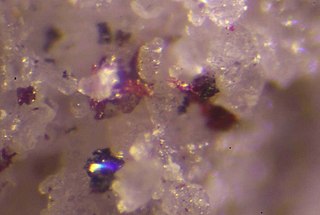 W
WRouthierite is a rare thallium sulfosalt mineral with formula Tl(Cu,Ag)(Hg,Zn)2(As,Sb)2S6.
 W
WSartorite is a lead arsenic sulfide with the chemical formula PbAs2S4 and as type locality the Lengenbach Quarry in Legenbach, Binnental, Valais, Switzerland. Historically, sartorite has been thought isomorphic to chalcostibite, emplectite, and zinckenite, but was definitively distinguished from the others in 1939.
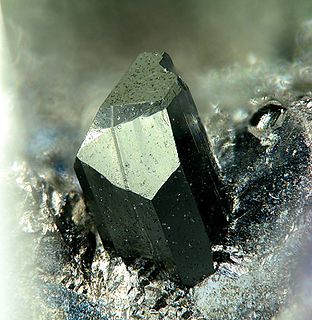 W
WSeligmanite is a rare mineral, with the chemical formula PbCuAsS3. Originally described from the Lengenbach Quarry, Valais Canton, Switzerland; it has also been found in the Raura district, Lima Region, Peru; at Tsumeb, Oshikoto Region, Namibia; and at the Sterling Mine, Sussex County, New Jersey, US.
 W
WStibarsen or allemontite is a natural form of arsenic antimonide (AsSb) or antimony arsenide (SbAs). The name stibarsen is derived from Latin stibium (antimony) and arsenic, whereas allemonite refers to the locality Allemont in France where the mineral was discovered. It is found in veins at Allemont, Isère, France; Valtellina, Italy; and the Comstock Lode, Nevada; and in a lithium pegmatites at Varuträsk, Sweden. Stibarsen is often mixed with pure arsenic or antimony, and the original description in 1941 proposed to use stibarsen for AsSb and allemontite for the mixtures. Since 1982, the International Mineralogical Association considers stibarsen as the correct mineral name.
 W
WWakabayashilite is a rare arsenic, antimony sulfide mineral with formula [(As,Sb)6S9][As4S5].
 W
WZimbabweite is a mineral; formula (Na,K)2PbAs4(Nb,Ta,Ti)4O18. It is generally classed as an arsenite but is notable for also containing niobium and tantalum. A yellow brown mineral with orthorhombic crystal habit and a hardness of 5. It was discovered in 1986 in kaolinized pegmatite, i.e. weathered to clay, in Zimbabwe.
 W
WZykaite or zýkaite is a grey-white mineral consisting of arsenic, hydrogen, iron, sulfur and oxygen with formula: Fe3+4(AsO4)3(SO4)(OH)·15(H2O). This dull mineral is very soft with a Mohs hardness of only 2 and a specific gravity of 2.5. It is translucent and crystallizes in the orthorhombic crystal system.